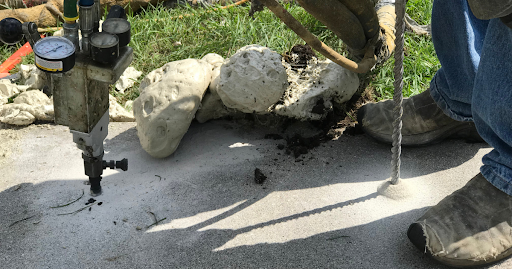Concrete surfaces are notorious for settling over time, causing issues like uneven driveways, sunken sidewalks, or sagging foundations. When it comes to restoring these surfaces, two popular methods have emerged as contenders: traditional mudjacking and the more modern polyurethane injection, often referred to as polyjacking. In this article, we’ll delve into the debate, exploring the pros and cons of mudjacking versus polyurethane and helping you decide which method might be the better fit for your concrete repair needs.
Understanding Mudjacking: The Time-Tested Technique

Mudjacking, also known as slabjacking or concrete leveling, has been a reliable method for decades. This technique involves drilling holes into the affected concrete and injecting a slurry mixture beneath the surface. This mixture, typically composed of soil, cement, and other additives, fills voids and raises the concrete to its original level. One of the main advantages of mudjacking is its cost-effectiveness, making it a popular choice for large-scale projects like driveways and foundations.
Polyurethane: The Modern Solution for Precision
Polyurethane injection, or polyjacking, is a newer alternative gaining popularity for its precision and efficiency. Instead of a slurry mix, polyurethane foam is injected beneath the concrete. This lightweight, expanding foam fills voids, lifts the concrete, and cures quickly. Polyurethane is known for its ability to reach even the smallest spaces, making it ideal for more delicate lifting jobs or situations where precision is crucial. While it may be a bit more expensive than mudjacking, the quick curing time and minimal disruption often offset the additional cost.
Key Factors to Consider:
Project Size:
Mudjacking is often more cost-effective for larger projects due to its use of locally available materials. Polyurethane, while precise, might be more suited for smaller-scale repairs.
Precision and Aesthetics:
Polyurethane foam’s ability to expand into tiny spaces makes it the go-to choice for projects where precision is paramount. If aesthetics and minimal surface disruption are crucial, polyurethane might be the better option.
Longevity:
Both mudjacking and polyurethane can provide durable results, but the longevity may depend on factors like soil stability and maintenance. Consulting with professionals can offer insights into the expected lifespan of each method for your specific project.
Finding the Right Solution Near You:
If you’re searching for “mudjacking services near me” or exploring polyurethane options, it’s essential to connect with local professionals. Local climate, soil conditions, and specific project requirements can influence the choice between mudjacking and polyurethane.
Conclusion: Making the Right Choice for Your Concrete Repair Needs
In the mudjacking vs polyurethane debate, there’s no one-size-fits-all answer. Both methods have their merits, and the choice depends on factors such as project size, precision requirements, and budget constraints. Whether you opt for the time-tested reliability of mudjacking or polyurethane, the key is to enlist the services of experienced professionals who can assess your unique situation and provide a tailored solution for a level and stable concrete surface.
Frequently Asked Questions
Is concrete leveling polyurethane better than mudjacking?
The decision between concrete leveling with polyurethane and mudjacking hinges on project specifics. Polyurethane is precise and quick-curing, ideal for smaller jobs, while mudjacking is cost-effective and better suited for larger projects. Both methods offer durability, and choosing the right one depends on factors like project size and budget constraints. Consulting with professionals is key for tailored advice on your concrete leveling needs.
What is the best material for concrete lifting?
The choice of the best material for concrete lifting depends on the specific needs of the project. Polyurethane is often favored for its precision and quick curing, making it suitable for smaller-scale repairs. On the other hand, mudjacking, using a slurry mix, is a cost-effective solution preferred for larger projects. The decision should consider factors like project size, precision requirements, and budget constraints. Consulting with professionals is essential to determine the most suitable material for effective and lasting concrete lifting.
How long does polyurethane jacking last?
The longevity of polyurethane jacking results varies depending on factors like soil stability, maintenance, and the specific conditions of the project. Generally, when professionally executed, polyurethane jacking provides a durable solution for lifting and leveling concrete surfaces. Regular inspections and proper care contribute to extending the lifespan of the polyurethane jacking repair, ensuring lasting results over an extended period.
What is the alternative to mudjacking?
An alternative to mudjacking is polyurethane injection, using lightweight foam to lift and level concrete. The choice depends on factors like project size, precision needs, and budget considerations. Consulting professionals can help determine the most suitable alternative for your concrete repair.
Is mudjacking a permanent fix?
Yes, mudjacking provides a lasting solution for sunken or uneven concrete surfaces. This method effectively addresses soil settlement issues, offering a reliable and durable fix. The longevity of the mudjacking repair is influenced by factors such as soil conditions, maintenance, and the quality of the initial repair work. When professionally executed, mudjacking typically results in a stable and long-lasting improvement to the concrete surface.
What is the best concrete leveling?
Determining the best concrete leveling method depends on project specifics. Mudjacking is a cost-effective solution preferred for larger projects, utilizing a slurry mix. Polyurethane injection, on the other hand, is precise and quick-curing, ideal for smaller-scale repairs. The choice should consider factors like project size, precision requirements, and budget constraints. Consulting with professionals is crucial to selecting the most suitable concrete leveling method tailored to your needs.
What is the cheapest way to level a concrete floor?
The most cost-effective way to level a concrete floor is typically through mudjacking. Mudjacking involves injecting a slurry mix beneath the uneven concrete, lifting it to its original level. This method is known for its affordability compared to alternatives like complete floor replacement or more precision-focused techniques. It provides an economical solution for addressing uneven surfaces and restoring stability to concrete floors.

